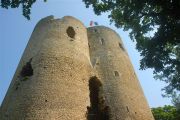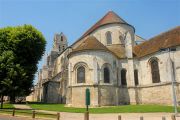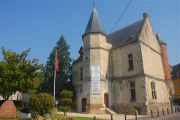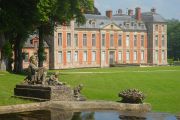50 km south of Paris, in the department of Essonnes, Étampes is a peaceful little town that keeps several monuments dating from the Middle Ages and the Renaissance. The surroundings also offer the possibility to practice sports and enjoy nature.
[ Practical ]
- Getting there
By road
50 km on autoroutes A6b, A10 then on N20
By train
RER C every 30 minutes from Paris
- Restaurants
La Terrasse Saint Gilles
Auberge de la Tour Saint Martin
Les Piliers
Île-de-France, in the leisure park
Le Buffet, in Chamarande
- Churches
Saint-Martin is open on Wednesday and Sunday afternoon.
Saint-Gilles is open Tuesday morning and Sunday afternoon.
Saint-Basile is open on Wednesday all day and Sunday afternoon.
Notre-Dame-du-Fort is open Saturday all day, Tueday, Wednesday, Friday and Sunday afternoon.
- Museum
Open from Wednesday to Sunday from 14.00 till 17.00
- Information
The tourism office offers thematic guided tours around town on some Wednesday, Saturday and Sunday.
Tel : 0169926900
Leisure park : 0164947618
www.baseregionale-etampes.fr
Few people know or even imagine Étampes was once a Royal town. But it’s true it dates back to the 11th and 12th centuries, at the time of Robert II the Pious and Louis VI the Fat, two early kings of the Capetian dynasty.

 Tour de Guinette © T.Joly Tour de Guinette © T.Joly
|
 Strategic fortress Strategic fortress
A massive 27 m high keep reminds the visitors this distant period as soon as they go out the RER. Overlooking the railway station, that’s the only remain of the Royal Castle built in the 11th century by Robert the Pious. All the rest was demolished in 1589 on order of Henri IV. A decision he took at the request of the inhabitants who were tired of seeing their city regularly attacked by troops wanting to seize this strategic fortress. Étampes is indeed located in a valley linking Paris to the fertile plains of the Beauce and beyond to Orléans. That's why it is crossed from north to south by important thoroughfares since ever. A situation that today makes it essentially a stopping-off place. But it wasn’t always like that. In the past, when means of transportation were slower, it was a perfect place to rest on the way from Paris to Orléans.

 Saint Martin Church © T.Joly Saint Martin Church © T.Joly
|
 Leaning bell tower Leaning bell tower
And it was the purpose of its foundation by the Romans, along one of their paved road, where is now the present neighborhood of Saint Martin d’Étampes. Terminus of the RER C line, it is snuggled up around a beautiful and vast 12th century church that has one particularity. A leaning bell tower that owes its slope to the swampy nature of the ground.
When they chose to stay in Étampes, the Kings of France preferred to settle down two kilometres North of this hamlet. That’s nowadays the centre of Étampes, which is dominated by the bell towers of two churches founded by the well--named Robert the Pious. Saint-Basile , a building mixing Middle Age and Renaissance architectures. Notre-Dame-du-Fort, a fortified church with a graceful 55 m high bell tower that keeps 16th century frescoes and stain glasses. Sign of the city importance in the 12th century, it hosted several councils of the Catholic church including the ones that chose the Pope Innocent II and decided the second crusade.

 Hôtel Anne de Pisseleu © T.Joly Hôtel Anne de Pisseleu © T.Joly
|
 Private mansions Private mansions
On the other hand the palace of the Capetian kings doesn’t exist anymore. It only remains an audience room and a fresco that are now part of the tribunal and so rarely visible. But the town’s historical heritage is not limited to religious buildings. There are also two beautiful private mansions from the 16th century, when the city became a duchy and was given by the kings Francis 1st and Henry II to their respective mistresses. Anne de Pisseleu and Diane de Poitiers who gave their names to this mansions even if they probably never lived in. Adorned with medallions featuring Cleopatra and Francis 1st , the first one houses the tourism office and exhibition rooms. The second one is now the city library and the inner courtyard façade has beautiful windows some historians believe to be works from the sculptor and architect Jean Goujon. The one who did the Fountain of the Innocents in Paris.
 19th century artists 19th century artists
As to the Saint-Yon private mansions, it was built for officers of the king during the late 15th century, at the end of the gothic period. A style that is also the one of the city hall built at the same time. However the building was extensively reshaped in the 19th century when a Renaissance style aisle was added. It houses a little museum that recalls the geology and the history of the town and the surroundings through archaeological pieces from prehistoric, Gallic, Roman and middle-ages times. But its main feature is a collection of works by 19th century artists. Portraitist Louise Abbéma, a close friend of actress Sarah Bernard. Orientalist painter Narcisse Berchère. Impressionist Edourd Béliard. Sculptor Elias Robert who also completed some of the statues adorning the theatre that bears a classical façade and an Italian interior.
 Ancient houses Ancient houses
Other neighbourhood with a long history, Saint Gilles grew up midway between the royal city and Saint Martin, around the market set up by king Louis VI the Fat in the 12th century. From that time remain few old houses called with pillars and a Romanesque church housing numerous graves of wealthy merchants. Saint Gilles square still hosts a market, on Tuesday morning, and is an enjoyable spot to have lunch at a terrace when the weather is fine. Small anecdote, according to a legend, it is in this district that in May, 1610 the murderer of Henri IV, Ravaillac, would have stopped and bought the fatal knife the day before his crime. In the course of the centuries the hamlets of Saint Martin and Saint Gilles as well as the royal city became larger and larger to form a single town spreading over more than two kilometres.
 Renaissance fortifications Renaissance fortifications
To go from one neighbourhood to another, the most enjoyable and interesting way is to walk along the waterways that cross the town and brought prosperity to her. In the past they were indeed used by the boats supplying grains to Paris. On their banks still rise numbers of washhouses and former mills as well as some vestiges of the fortifications that surrounded the city in the Renaissance. The Portereaux are the finest example. That’s a blockhouse provided with machicolations and loop-holes located where rivers Louette and Chalouette joins to form the Rivière d’ Étampes.
Almost right in front, in a public garden, history gives place to modern art with “La Pergola de la Douce France”. Completed by a group of artists including Pompon and Zadkine, this works is remarkable for the bas reliefs inspired from Celtic legends that adorn its rectangular pillars.

 Pergola de la Douce France © T.Joly Pergola de la Douce France © T.Joly
|
 Architecture International Great Prize Architecture International Great Prize
Presented to the 1925 Paris International Decorative Arts Exhibition, it got the Architecture international Great Prize and ended in Étampes because Parisians didn’t want it in any of their public squares !!!!
But the town has more to offer than monuments and ancient buildings. It also possesses a leisure park with a wave pool and a lake where it’s possible to practice many activities. Climbing, archery, tennis, fishing, VTT, hiking, pony riding, canoe, water bicycle…. Or simply have lunch by the water, picnic or rest between two visits.
Lastly, it would be a pity not to take advantage of a day in Étampes to go to Chamarande. Situated in only two RER stations away in the direction of Paris, this charming village possesses a magnificent 17th century castle.

 Chamarande castle © T.Joly Chamarande castle © T.Joly
|
 Contemporary art Contemporary art
Built with bricks and sandstone in a Louis XIII style, it is surrounded with an English-style park of 98 ha which offers a large variety of landscapes. Meadows, streams, ponds, island, kitchen garden, small waterfall, exotic trees and thick wood where hide roe deers. A place loan of serenity where it’s nice to stroll around and which brings its share of surprises: a life-size snakes and ladders, an icebox, an orangery, a detached house - belvedere where noble persons met to chat or listen music, and several modern sculptures. Indeed, on its owner, the Conseil Général de l’Essonne, instigation, the domain is now dedicated to contemporary art. Thus the castle hosts regularly plastic and visual arts exhibitions whereas concerts, dance shows and sessions of outdoor cinema are given in the park. All events are free of charge.
July 09, 2008
Thierry Joly 

|



